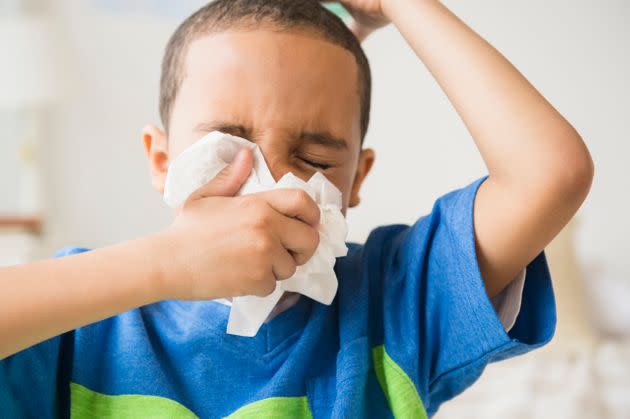These Are The Symptoms Of The Delta Variant In Kids

The highly contagious delta variant has transformed the COVID-19 pandemic, and is accounting for the overwhelming majority of new cases across the U.S. And new cases in children are up 85% in recent weeks, prompting groups like the American Academy of Pediatrics and the Centers for Disease Control and Prevention to send a clear message: Delta is different.
But is delta different in terms of how symptoms show up in kids? Here’s what parents need to know:
For now, the main symptoms look pretty much the same as before
The COVID-19 symptoms doctors are seeing in young patients now are largely similar to what they’ve been seeing thus far: fever, cough, congestion, gastrointestinal issues, and a loss of taste or smell. Among those, fever and cough appear to be especially common in children.
But those are by no means the only possible symptoms. (The CDC has information about others that people of all ages can experience.) Estimates also suggest that anywhere between 16% and 40% of kids infected with COVID-19 are asymptomatic, although those estimates come from research conducted before delta became the dominant strain in the U.S.
So for now, experts say parents and caregivers should really continue to be on the lookout for the same kind of symptoms kids have been experiencing all along.
“We haven’t seen any change in clinical presentation with the delta variant,” said Dr. Anupama Kalaskar, medical director of infectious diseases at Children’s Minnesota. “But we have seen an increased number of cases and increased percent positivity of tests, which reflects increased community transmission.”
Cases and hospitalizations in children have skyrocketed
Even though the main symptoms appear to be pretty steady at this point, delta has transformed the pandemic for kids because there has been a marked increase in new pediatric cases and hospitalizations. Children now represent about 15% of all new infections nationwide.
“Just a few weeks ago, we hadn’t been seeing any kids in the hospital. Now, every day, I have one or two,” said Dr. James Schneider, chief of pediatric critical care at Cohen Children’s Medical Center in New Hyde Park, New York.
Elsewhere in the country, that increase is even more pronounced. Hospitals in COVID-19 hotspots around the U.S. have warned they’re running out of beds for pediatric patients.
That uptick in hospitalizations seems to reflect the fact that delta is more contagious, and that children are more vulnerable because they’re not yet eligible for vaccination.
“It doesn’t seem to be that it’s causing kids to get sicker; it’s just causing many more kids to get sick,” Schneider said. “It seems like that is the current scenario right now.” Like all of the physicians interviewed for this story, he was quick to note that doctors are still learning about all of this in real time.
Experts also point out that children are venturing out into the world now more than they were during previous coronavirus surges, which might be another reason why they’re experiencing more infections.
“Younger children were more protected from getting infected with previous COVID waves,” said Dr. Audrey John, chief of infectious diseases at Children’s Hospital Philadelphia. “School closures, halting extracurricular activities, masking, distancing — all these things kept kids and adults safe. Now that things are more open, young kids and unvaccinated adults are at risk.”
Testing and masking remain crucial
The AAP and CDC have called for a return to in-person school this fall with universal masking, but that has become a hot-button political issue. Many areas are rejecting mask mandates, even as case numbers continue to climb.
“It’s critically important that kids — vaccinated or not — wear masks indoors and in school,” Schneider said.
He said it’s also vital for parents to get their children tested for COVID-19 if they develop symptoms like sniffles, a cough or a fever. Many symptoms overlap with the common cold or other respiratory issues. There’s an ongoing summer surge in RSV, for example, which generally causes mild cold-like symptoms but can sometimes be serious, particularly for babies.
“I absolutely would get kids tested,” said Schneider, who added that he recently got his own son tested when he developed some mild upper respiratory issues. “There’s no downside to doing it.”
Even children who have mild symptoms or no symptoms at all may develop long-haul COVID, which experts are still learning about. It’s unclear whether the delta variant has any impact on long-term symptoms and outcomes, or if it has any implications for multisystem inflammatory syndrome in children (MIS-C).
“We don’t know if or how the presentation of MIS-C may change quite yet as that occurs weeks after acute infection,” Kalaskar said.
MIS-C — a syndrome that can make children very sick with a fever, causes inflammation in their bodies, and may cause problems with their organs — continues to be rare. There have been just over 4,000 known cases in the U.S. since the pandemic began, out of more than 4 million known COVID-19 cases in kids.
Although parents should remain diligent about getting eligible children vaccinated and enforcing mask-wearing as we head into a new school year, the overall picture for children is still largely reassuring.
“While we still don’t understand the long-term effects of getting infected with SARS-CoV-2, we are still fortunate that very few children are hospitalized with COVID-19 or with the post-coronavirus syndrome, MIS-C,” John said.
Experts are still learning about COVID-19. The information in this story is what was known or available as of publication, but guidance can change as scientists discover more about the virus. Please check the Centers for Disease Control and Prevention for the most updated recommendations.
This article originally appeared on HuffPost and has been updated.

 Yahoo Sport
Yahoo Sport 









































